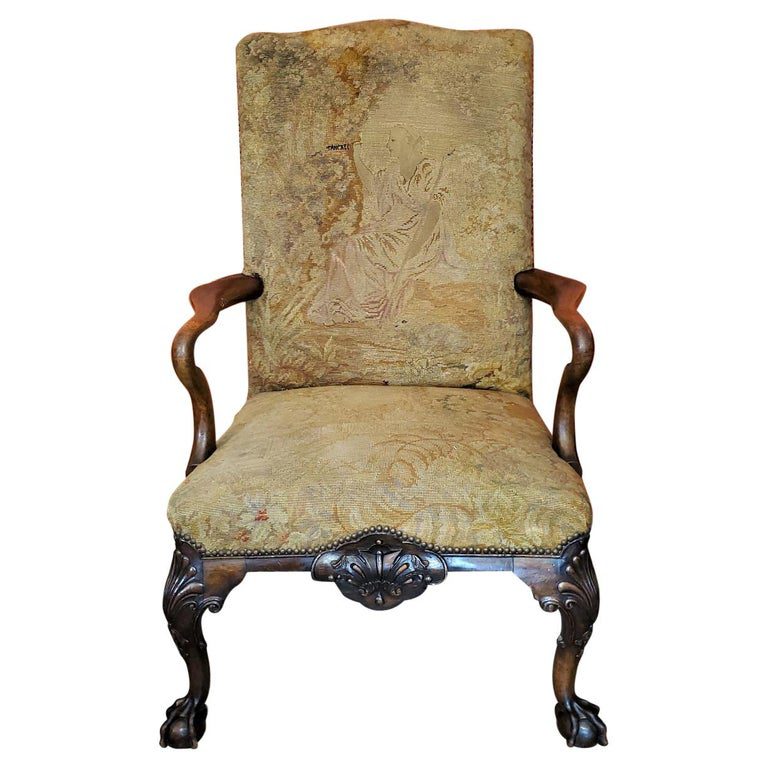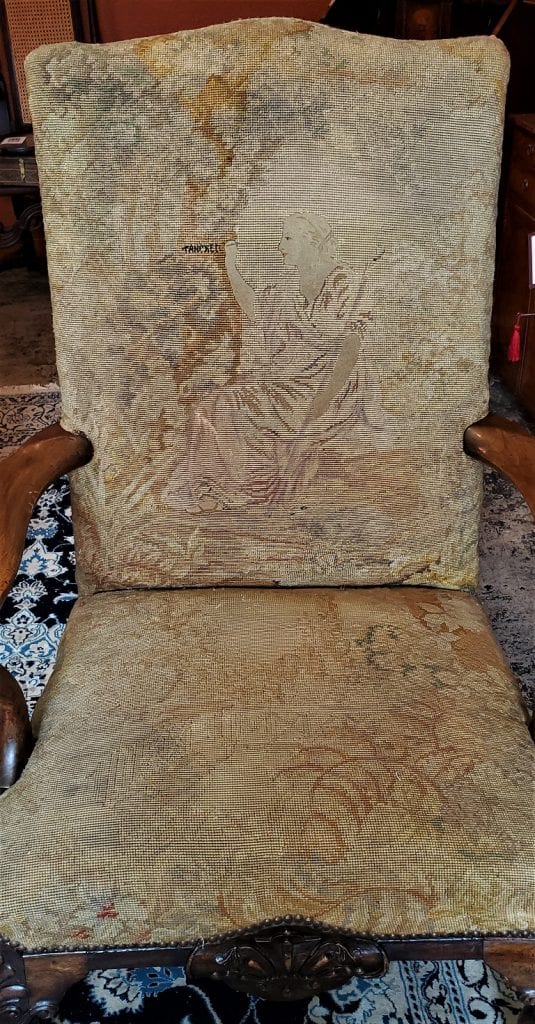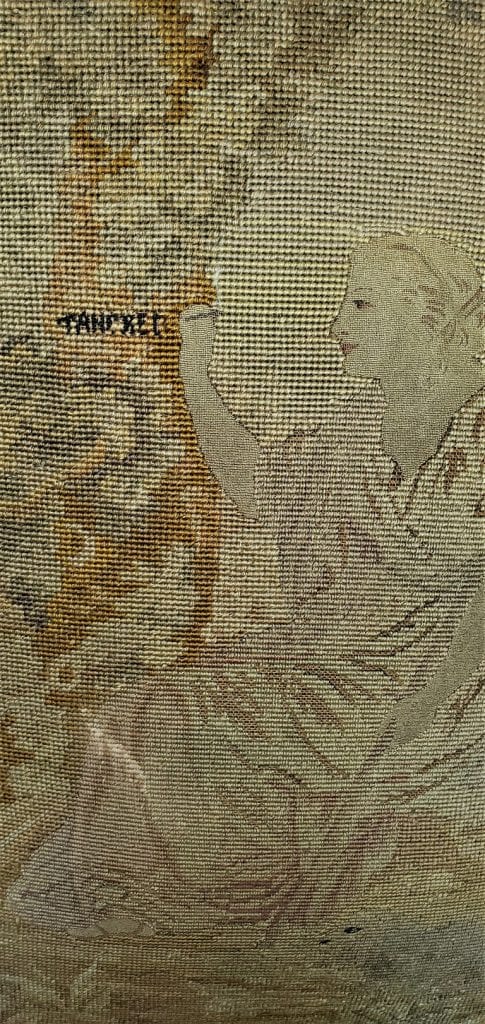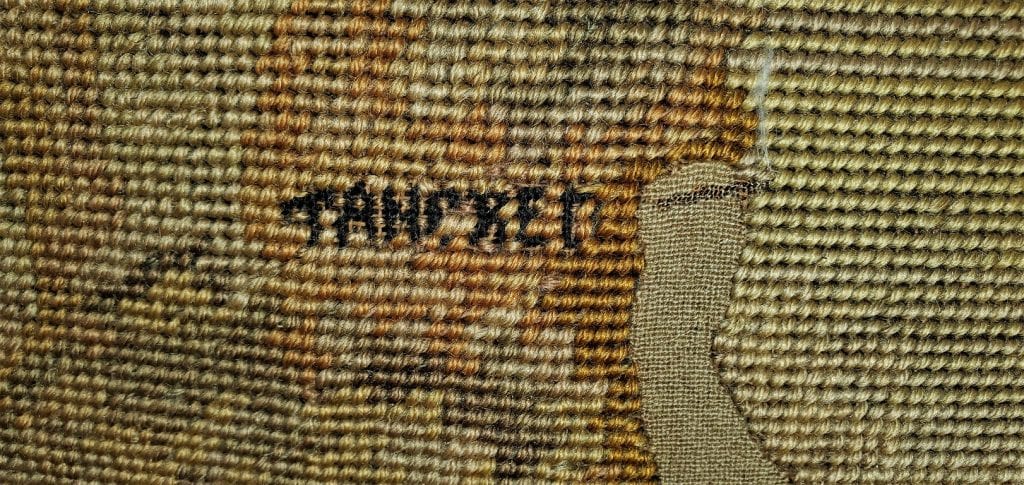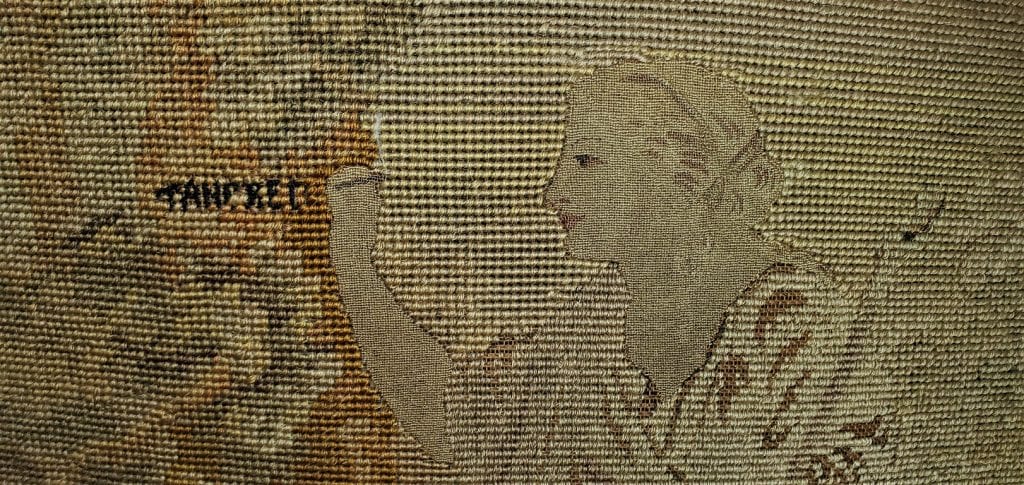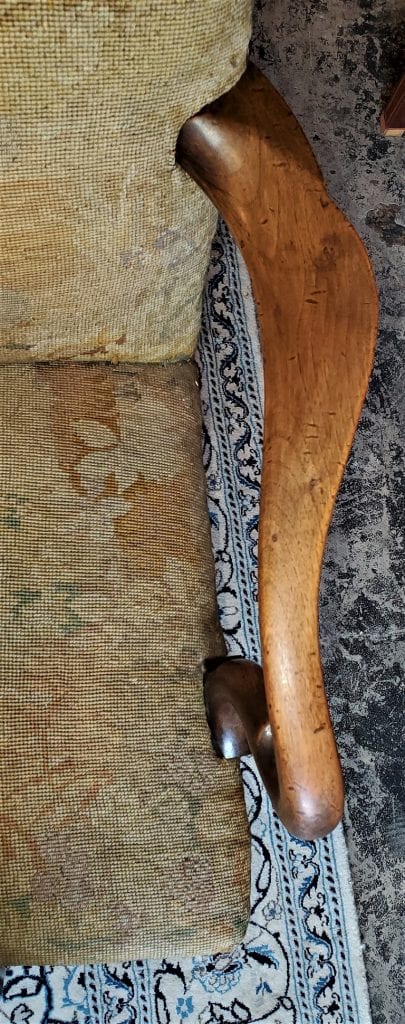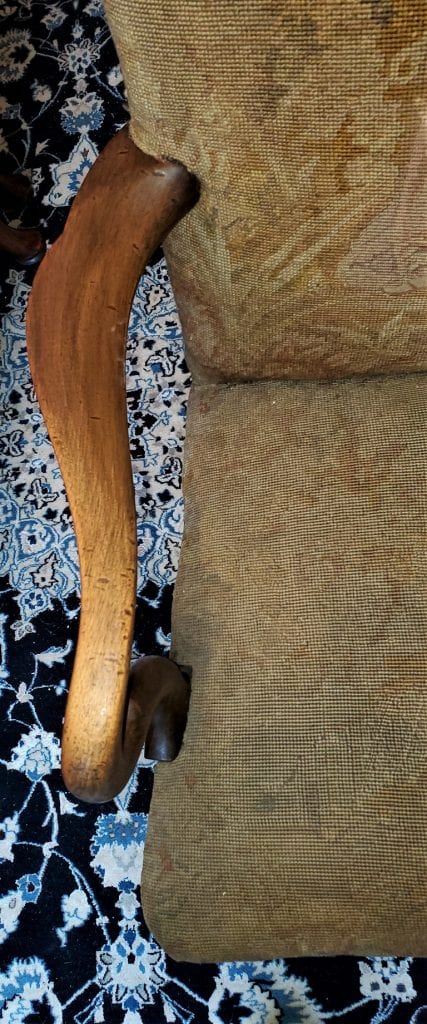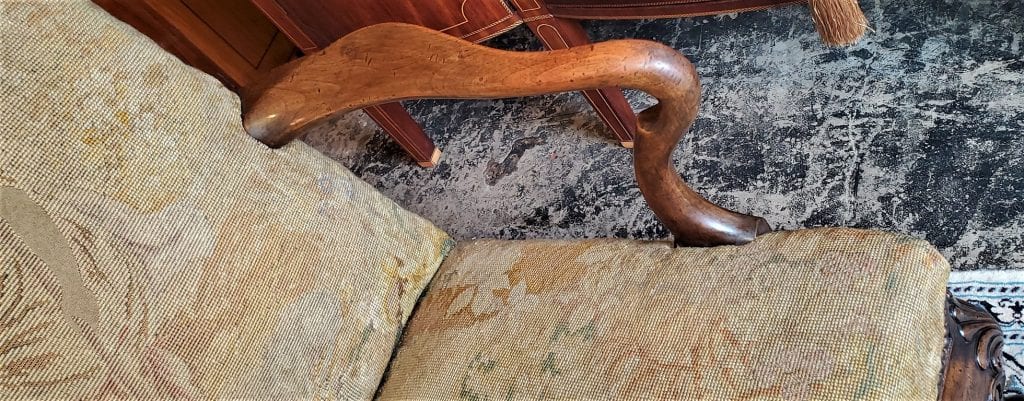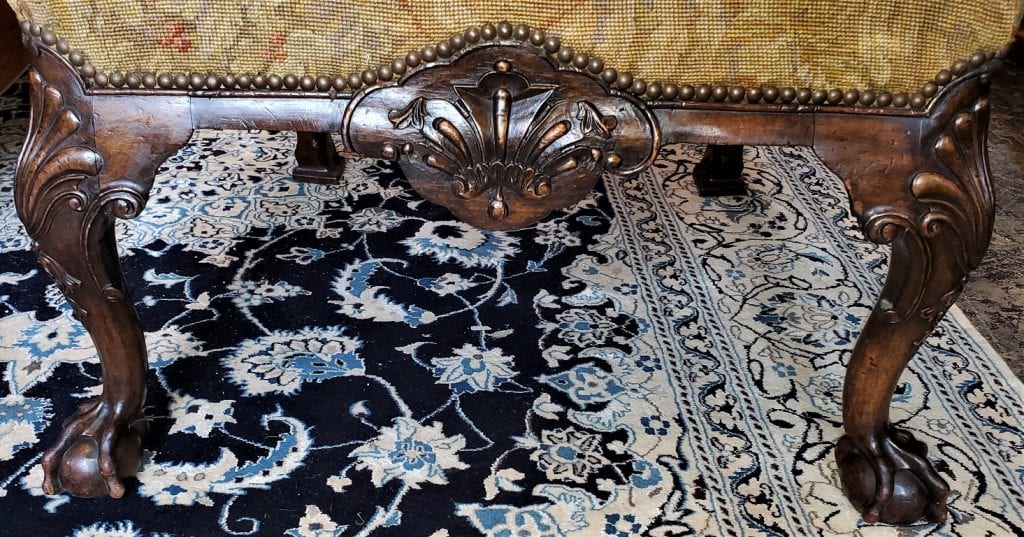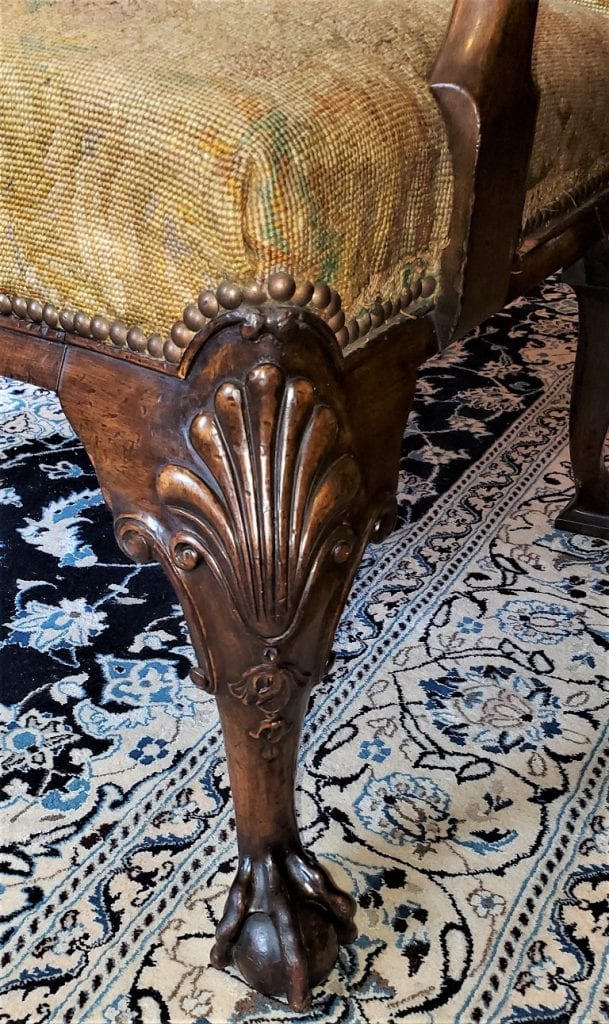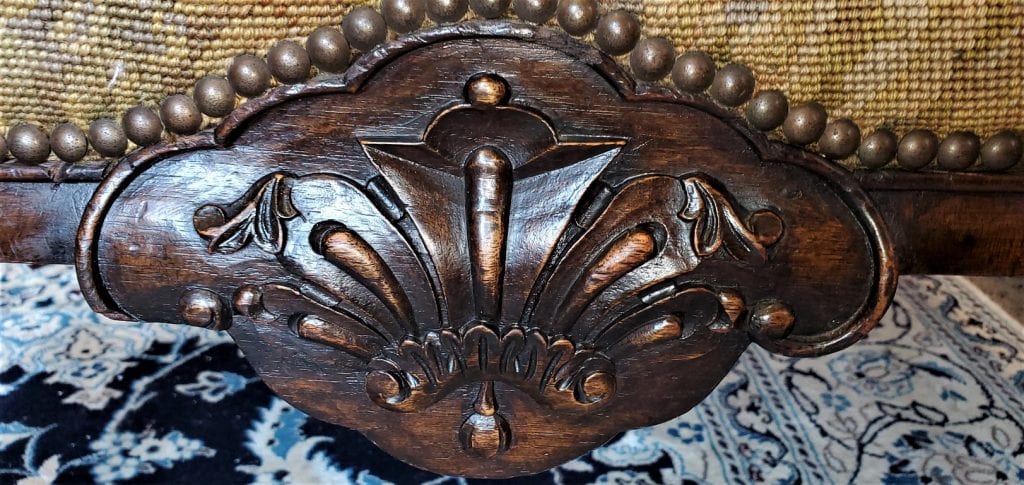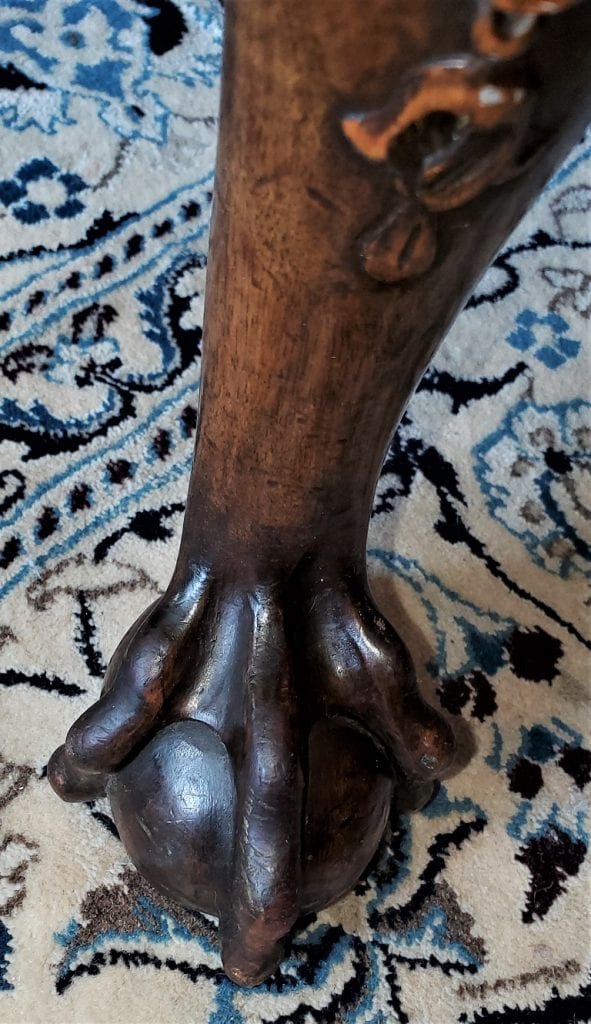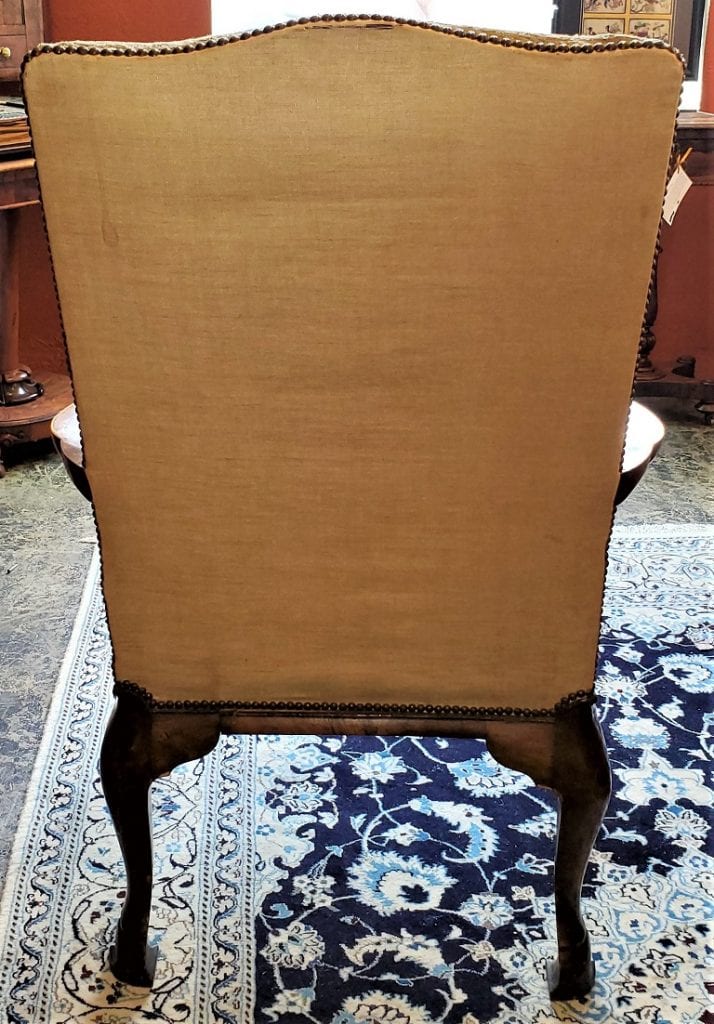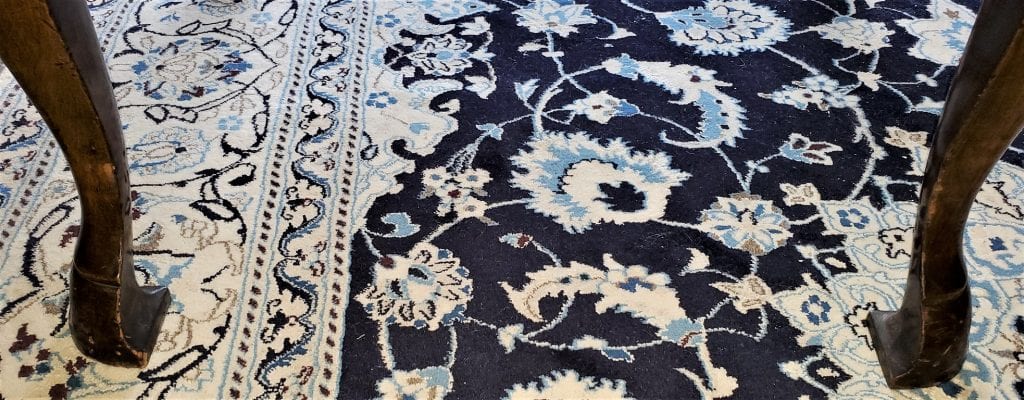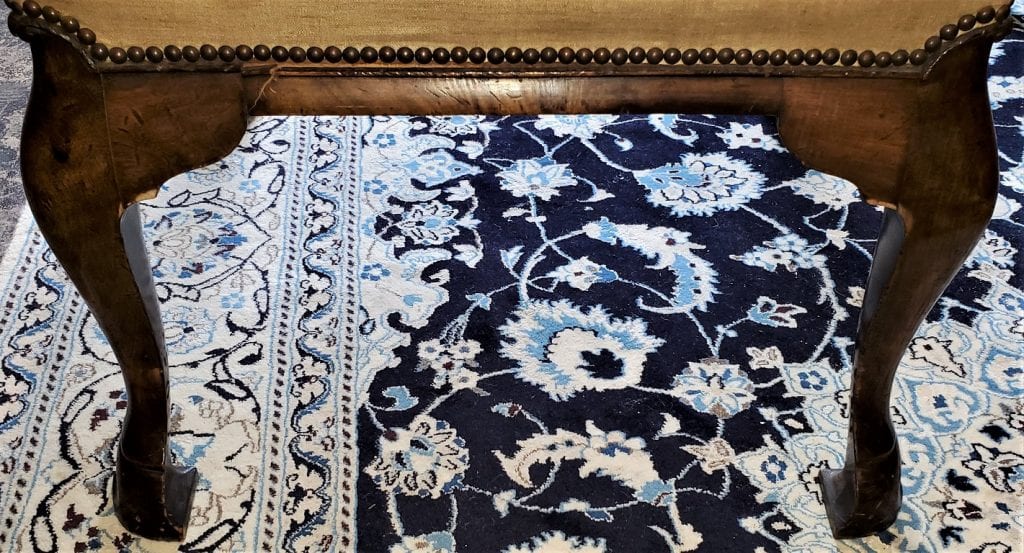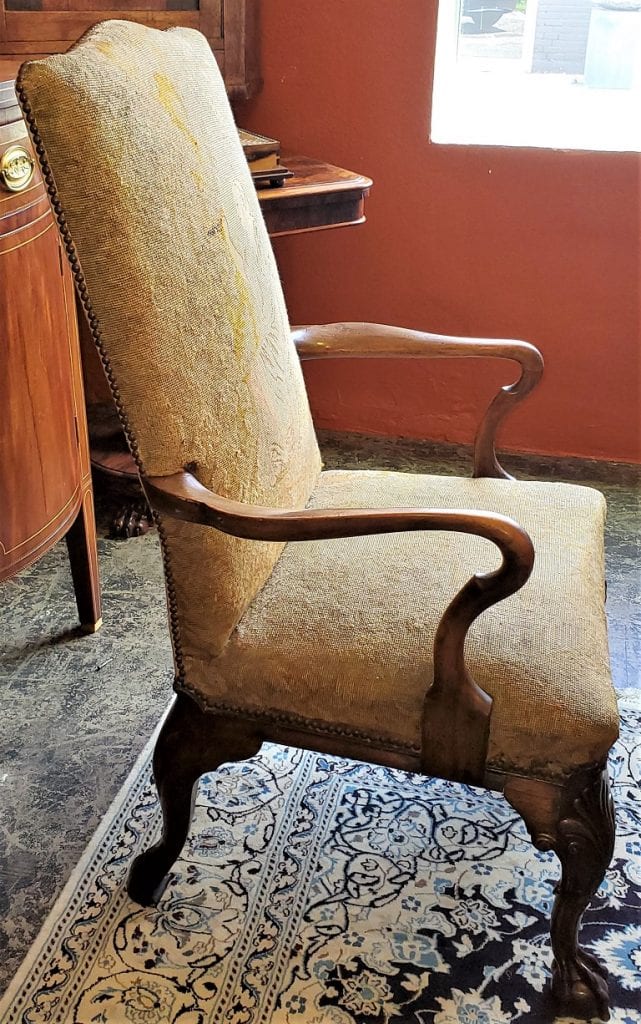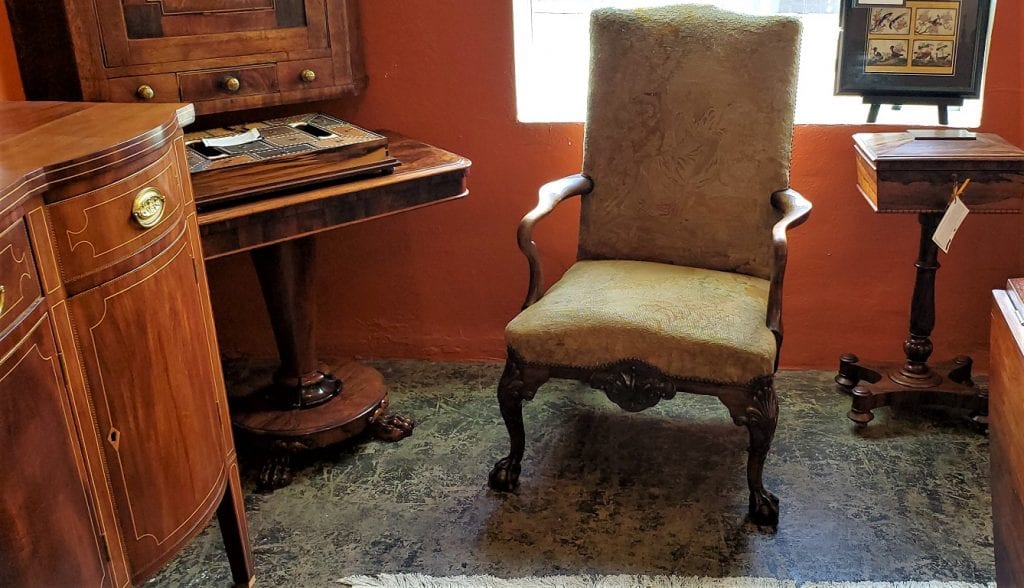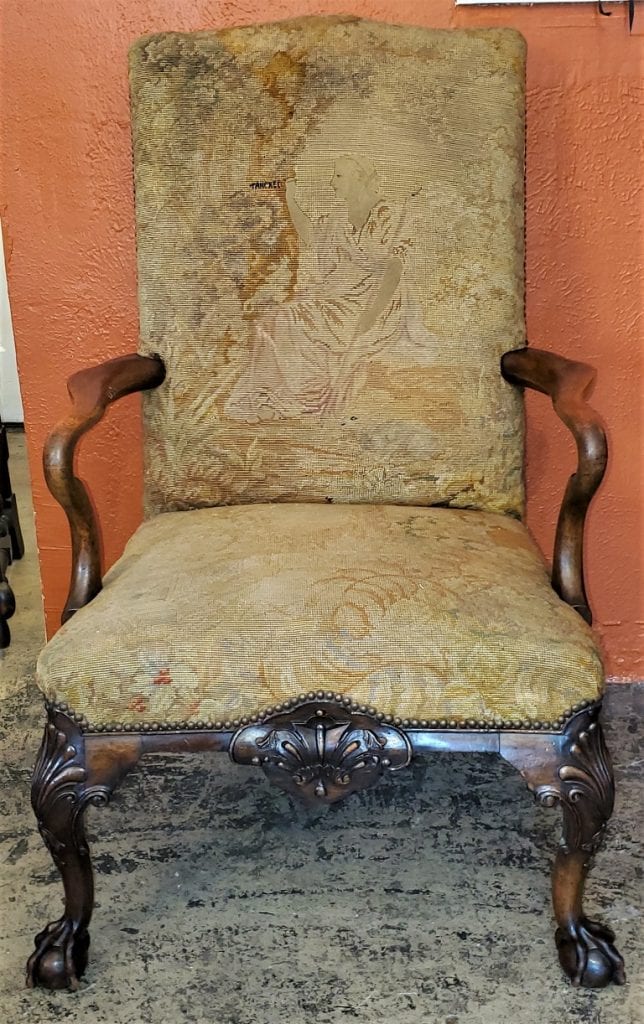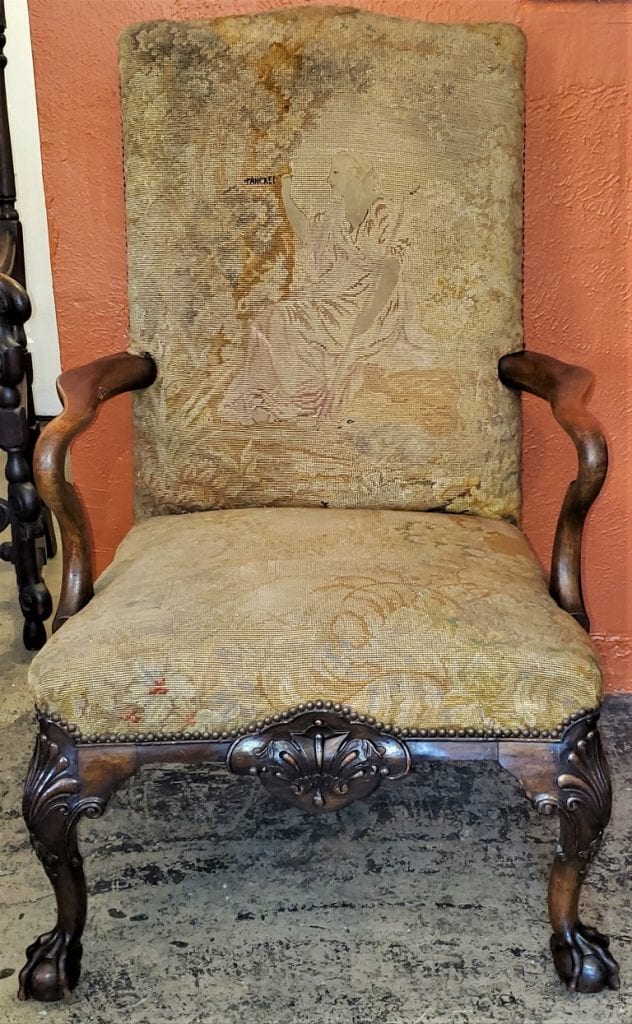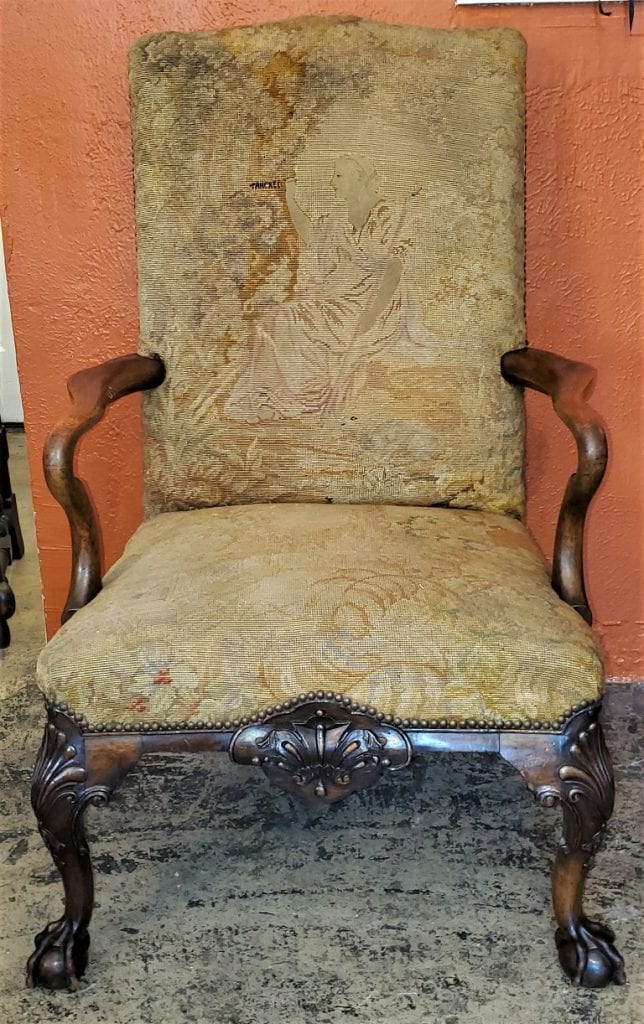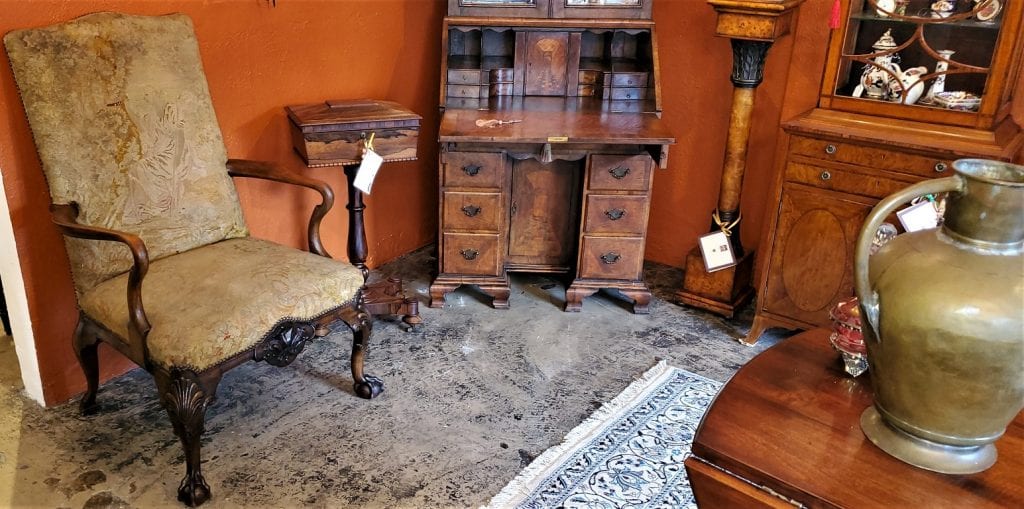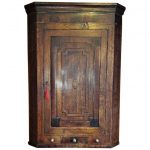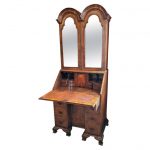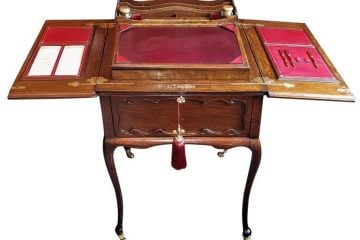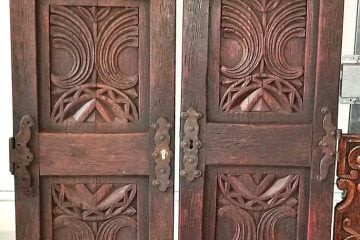18C English Chippendale Shepherds Crook Armchair
PRESENTING an ABSOLUTELY STUNNING and ORIGINAL 18C English Chippendale Shepherds Crook Armchair.
Made in England circa 1780-1800 of walnut, this ‘period’ chair is simply GORGEOUS in it’s ORIGINALITY !
It is still covered in it’s original needlepoint/tapestry upholstery with neo-classical elements of a Greek or Roman Goddess sitting holding a staff on the back splat and floral motiff’s elsewhere.
What makes this piece TRULY ORIGINAL is the fact that the needlepoint appears to have been signed by the original owner/maker of the tapestry and it appears to be the family name of “Tancret”.
The arm rests have the most glorious ‘shepherd’s crook’ twists and turns.
The central base section has what appears to be heavily carved Prince of Wales Plumes, signifying the Regency Era.
The knees of the 2 front legs have the most amazingly carved acanthus relief decoration and the 2 front legs end in the best example of ball and claw feet you are ever likely to see.
The back legs also have some interesting detail as the feet are platformed or hooved.
Overall, the piece is in great condition for it’s age and use. There are no major tears or holes in the original tapestry. There is some discoloration but that is to be expected with a piece this old.
There is a very small piece of the central front medallion (bottom left as you look) missing, but it is not noticeable and does not detract from the piece.
One small stain on the back.
Gorgeous natural patina to the wood.
The Regency in the United Kingdom of Great Britain and Ireland was a period at the end of the Georgian era, when King George III was deemed unfit to rule due to his illness, and his son ruled as his proxy, as prince regent. Upon George III’s death in 1820, the prince regent became King George IV. The term Regency (or Regency era) can refer to various stretches of time; some are longer than the decade of the formal Regency, which lasted from 1811 to 1820. The period from 1795 to 1837, which includes the latter part of George III’s reign and the reigns of his sons George IV and William IV, is sometimes regarded as the Regency era[citation needed], characterised by distinctive trends in British architecture, literature, fashions, politics, and culture.
The Regency is noted for its elegance and achievements in the fine arts and architecture. This era encompassed a time of great social, political, and economic change. War was waged with Napoleon and on other fronts, affecting commerce both at home and internationally, as well as politics. However, despite the bloodshed and warfare, the Regency was also a period of great refinement and cultural achievement, which shaped and altered the societal structure of Britain as a whole.
One of the greatest patrons of the arts and architecture was the Prince Regent himself (the future George IV). Upper-class society flourished in a sort of mini-Renaissance of culture and refinement. As one of the greatest patrons of the arts, the Prince Regent ordered the costly building and refurbishing of the beautiful and exotic Brighton Pavilion, the ornate Carlton House, as well as many other public works and architecture (see John Nash, James Burton, and Decimus Burton). Naturally, this required dipping into the treasury, and the Regent, and later, the King’s exuberance often outstripped his pocket, at the people’s expense.
Link: https://en.wikipedia.org/wiki/Regency_era
THE HISTORY OF THE ‘TANCRET” FAMILY
The vast movement of people that followed the Norman Conquest of England in 1066 brought the Tancret family name to the British Isles. Tancret comes from the ancient Norman given name Tancred. The Tanksley variant is indeed rare. However, this name traces its origin to Roger Tankerlayman who was listed in Yorkshire in 1387.
Tankersley is a parish, in the union of Wortley, wapentake of Staincross, in the West Riding of Yorkshire [2] and dates back to the Domesday Book of 1086 when it was first listed as Tancresleia. [3] Literally the place name means “woodland clearing of a man called Thancred,” from the Old English personal name + “leah.”
Early Origins of the Tancret family
The surname Tancret was first found in Yorkshire where they held a family seat as Lords of the manor of Boroughbridge in that shire. They were descended from Tancred, son of the Good Marqis, who governed the principality of Antioch as Guardian of the Emperor Bohemond II. Tancred, whose barony was in Normandy in 912 A.D. was also the sire of the celebrated Tankervilles. Whixley in the West Riding of Yorkshire was home to one branch of the family.
“The living [of Whixley] is a perpetual curacy, valued in the king’s books at £7. 17. 1.; net income, £68; patrons and impropriators, the Governors of the Tancred charities. Christopher Tancred, Esq., whose family were long seated at the Hall, at his death in 1754, left his house to be converted into an hospital for twelve decayed gentlemen, and endowed it with estates which, in 1815, were let for £2480 per annum.” [2]
Much father to the south in Cornwall, the Tencreek family was found. This variant is rare today but at one time, they held many manors and estates. By example, at one time the manor of Ellenglaze, in St. Cuthbert belonged to the family of Tencreek.
Early History of the Tancret family
This web page shows only a small excerpt of our Tancret research. Another 88 words (6 lines of text) covering the years 1187, 1663, 1703, 1665, 1744, 1759, 1689, 1754, 1685 and 1686 are included under the topic Early Tancret History in all our PDF Extended History products and printed products wherever possible.
Tancret Spelling Variations
Multitudes of spelling variations are a hallmark of Anglo Norman names. Most of these names evolved in the 11th and 12th century, in the time after the Normans introduced their own Norman French language into a country where Old and Middle English had no spelling rules and the languages of the court were French and Latin. To make matters worse, medieval scribes spelled words according to sound, so names frequently appeared differently in the various documents in which they were recorded. The name was spelled Tancred, Tancard, Tancert, Tancrette, Tankard and many more.
Early Notables of the Tancret family (pre 1700)
Outstanding amongst the family at this time was Sir Thomas Tancred, 1st Baronet (d. 1663), descendant of Richard Tankard, who owned lands at Boroughbridge in Yorkshire; Sir William Tancred, 2nd Baronet (d. 1703); Sir Thomas Tancred, 3rd Baronet (1665-1744); and Sir Thomas Tancred, 4th Baronet (d. 1759). Christopher Tancred (1689-1754), was an English benefactor, born Whixley, the second…![]()
Some of the Tancret family moved to Ireland.
Migration of the Tancret family
Because of this political and religious unrest within English society, many people decided to immigrate to the colonies. Families left for Ireland, North America, and Australia in enormous numbers, traveling at high cost in extremely inhospitable conditions. The New World in particular was a desirable destination, but the long voyage caused many to arrive sick and starving. Those who made it, though, were welcomed by opportunities far greater than they had known at home in England. Many of these families went on to make important contributions to the emerging nations of Canada and the United States. Analysis of immigration records indicates that some of the first North American immigrants bore the name Tancret or a variant listed above: Walter Tankard arrived in Virginia in 1716; William Tankard settled in Virginia in 1606; 14 years before the “Mayflower”; William Tankard settled in Maryland in 1774.
Link: https://www.houseofnames.com/tancret-family-crest
18C English Chippendale Shepherds Crook Armchair.
Provenance: From a Wealthy Estate in Kentucky/Tennessee
Condition: Very good. See full description.
Dimensions: 44″ Tall, 28″ Wide and 27″ Deep
Seat Height of 18.5″ with seat depth of 17.5″ and interior seat width of 22.5″
Armrests are 26.25″ Tall
SALE PRICE NOW: $12,000 – $6,800
